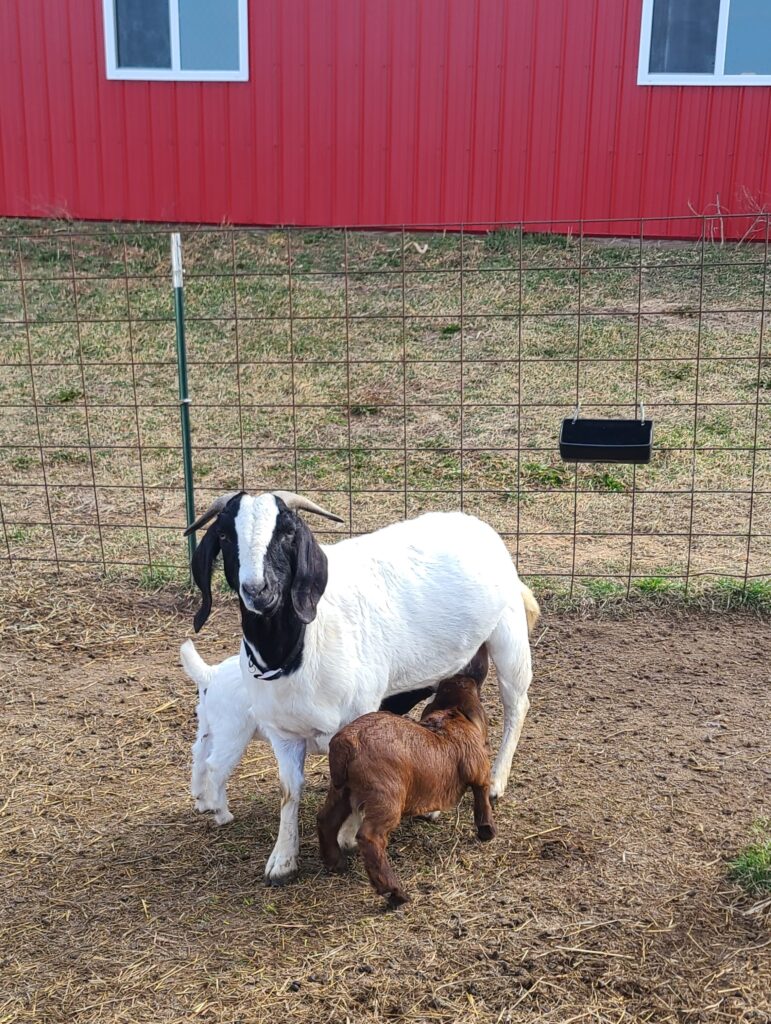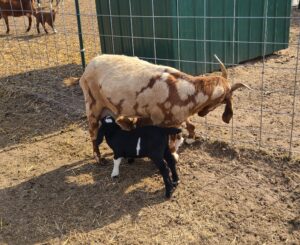When managing a goat herd, you have to choose between dam-raising and bottle feeding kids. There are pros and cons to each scenario, but here are the reasons why we prefer dam-raising on our farm.

This post contains affiliate links. As an Amazon Associate, I earn from qualifying purchases.
Sure, bottle feeding a baby goat is fun. There is nothing more adorable or rewarding than watching a bottle baby’s tail wag while you fill his belly with milk, but there are reasons why I prefer that the kids on my farm be dam-raised.
I raise Boers and Nubians and have a herd numbering between 20 and 40 goats, depending on the time of year. Bottle feeding that many kids would be possible with a lambar, but it doesn’t fit my farm set-up or goals. My goats are used for milk, meat, showing, and targeted grazing/ brush removal. They are managed as holistically as possible in a pasture-based system.
I have reared many kids on a bottle over the 30 years that I have owned goats and have done direct comparisons between those kids and their dam-raised counterparts. The following is based on my personal experience, I encourage you to collect your own data and find what works best for your operation.
1. Dam-raised Kids Grow Faster
In the first month of life, dam-raised kids on my farm exhibit a far greater daily rate of gain than those that are exclusively bottle fed. There are several factors that contribute to this occurrence. First, dam-raised kids are fed on demand and therefore can eat anytime they want unlike bottle babies that have to stick to a farmer-dictated schedule.
Second, getting a baby goat to take a bottle takes time. Dam-raised kids have instinct on their side and nurse more quickly than bottle kids. A dam-raised kid will have scent and their mom’s nudges to get them started off consuming calories. Bottle babies need help finding an artificial nipple and stimulation to get them suckling. Bottle feeding is a learned behavior, slower learners often lose weight as they get the hang of it. The good news is that once they get it, they are off and running and by the second month of life, those kids exhibit rates of gain equal to that of my dam-raised kids.
Dam-raised kids only grow faster providing that their mom has adequate milk supply. I let my does rear singles or twins, when I have triplets or quads I pull kids and make them bottle babies so that everyone gets enough to eat. My Nubians never have issues raising twins, the Boers on the other hand don’t produce as much milk so I keep an eye on them and supplement if necessary.
2. Dam-raised Kids are Healthier
Dam-raised kids get antibodies and balanced nutrition from the milk that they consume from their moms. Bottle babies that drink real goat’s milk would receive the same benefits. The difference comes with the use of powdered milk replacer, which many bottle babies rely on.
There are high-quality milk replacers out there, but even the best ones aren’t as good as the real thing. Scours are more of an issue with bottle babies than dam-raised kids, as is enterotoxemia.
3. Dam-raised Kids are Well-Adjusted
In my opinion, bottle babies are noisy, needy, and pushy and stay that way into adulthood. It’s cute when a bottle baby jumps up on you, but potentially dangerous when a grown, heavy animal doesn’t understand boundaries or personal space.
I much prefer handled, docile dam-raised kids than ones that think I am their mother. My dam-raised kids are still friendly and easy to work with, just less annoying than bottle babies.
Of course, dam-raised kids are only well-adjusted if you put time and effort into taming and handling them. If you leave them be and don’t expose them to people and all of the things people do, they are likely to be fearful and resistant to being caught, led, and worked with.
4. Dam-raised Kids are Smarter
Dam-raised kids are accompanied by a teacher, their mom! They will use her as an example of how to act and learn what foods to eat and which to avoid. This transference of knowledge is especially valuable to me when my goats are out on grazing jobs and encounter potentially toxic vegetation.
Bottle raised kids will have to learn everything on their own, some of them will learn things the hard way and that’s ok too.

5. Dam-raising is Less Time Consuming for the Producer
Bottle feeding is a lot of work and a huge time commitment. Not only do you need to train baby goats to take an artificial nipple, but you also have to milk or mix up milk replacer, feed the kids, and then clean thoroughly clean all of the equipment at least twice daily. Hygiene and cleanliness are very important for keeping bottle-fed kids healthy.
Dam-raised kids on the other hand, require taking good care of the lactating doe to keep her milk supply up. For me, this involves providing grain, high quality forage, lots of fresh water, and clean bedding to help prevent mastitis.
In addition, bottle-feeding kids will tie you down to a strict schedule. In contrast, dam-raised kids can be cared for with more flexibility because the doe is doing all of the work feeding on demand. For our bottle-feeding schedule for Boer or Nubian goats, click here.

Mother, farmer, author, and teacher by trade… She loves tending to things and watching them grow!

Sam you are a great writer and get your point across in an interesting fashion. Easy to read, easy to understand, and fun